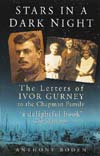
 |
| Opinion, Commentary, Dialogue |
|
Stars in a Dark Night: The Letters of Ivor Gurney to the Chapman Family. [Edited by] Anthony Boden with a foreword by Michael Hurd. NEW EDITION! Completely new and expanded second edition. Gloucester, UK: Sutton Publishing , 1986. [224 pp., ISBN: 0750934670, paperback, More Information & Reactions] www.amazon.co.uk, www.abebooks.co.uk, www.suttonpublishing.co.uk Stars in a Dark Night: The Letters of Ivor Gurney to the Chapman Family. [Edited by] Anthony Boden with a foreword by Michael Hurd. 1st Ed. Gloucester, UK: Alan Sutton, 1986. [126 pp.] Amazon*OP - but still available 8/05
|
 |
| To Respond . . . . If you would like
to respond
to what is written here, or contribute other Perspectives, Opinions, or
Commentary on Ivor Gurney, please write to: ivor@gurney.net
Subject to editorial review, responses will be posted on this site. |
To Respond Rolf Jordan’s ‘Stars’ Review Rolf Jordan’s ‘Anthem’ Review Janet Anderson’s ‘Watercolours’ Review Philip W. Guest’s ‘Battlefields’ Back to Perspectives |
| To Respond . . . . If you would like
to respond
to what is written here, or contribute other Perspectives, Opinions, or
Commentary on Ivor Gurney, please write to: ivor@gurney.net
Subject to editorial review, responses will be posted on this site. |
To Respond Rolf Jordan’s ‘Stars’ Review Rolf Jordan’s ‘Anthem’ Review Janet Anderson’s ‘Watercolours’ Review Philip W. Guest’s ‘Battlefields’ Back to Perspectives |
| To Respond . . . . If you would like
to respond
to what is written here, or contribute other Perspectives, Opinions, or
Commentary on Ivor Gurney, please write to: ivor@gurney.net
Subject to editorial review, responses will be posted on this site. |
| To Respond . . . . If you would like
to respond
to what is written here, or contribute other Perspectives, Opinions, or
Commentary on Ivor Gurney, please write to: ivor@gurney.net
Subject to editorial review, responses will be posted on this site. |
To Respond Rolf Jordan’s ‘Stars’ Review Rolf Jordan’s ‘Anthem’ Review Janet Anderson’s ‘Watercolours’ Review Philip W. Guest’s ‘Battlefields’ Back to Perspectives |
|
|
